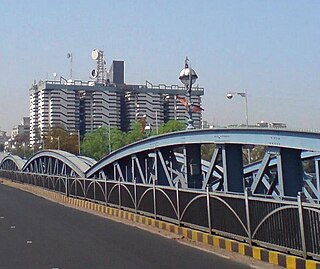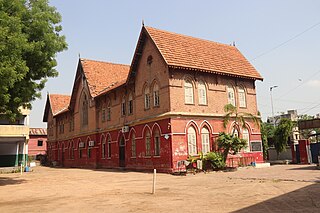Related Research Articles

Ahmedabad is the most populous city in the Indian state of Gujarat. It is the administrative headquarters of the Ahmedabad district and the seat of the Gujarat High Court. Ahmedabad's population of 5,570,585 makes it the fifth-most populous city in India, and the encompassing urban agglomeration population estimated at 6,357,693 is the seventh-most populous in India. Ahmedabad's 2024 population is now estimated at 8,854,444. Ahmedabad is located near the banks of the Sabarmati River, 25 km (16 mi) from the capital of Gujarat, Gandhinagar, also known as its twin city.
This page provides a historical timeline of Ahmedabad, the sixth largest city in India.

Kasturbhai Lalbhai was an Indian industrialist and philanthropist. He co-founded Arvind Mills along with his brothers and several other institutes. He was a co-founder of the Ahmadabad Education Society which later founded Ahmedabad University and the Indian Institute of Management Ahmedabad. Lalbhai served as the chairman of the historic and influential Anandji Kalyanji Trust, that manages Shatrunjaya and several other Jain pilgrimage centers, for 50 years.

Ranchhodlal Chhotalal, Rai Bahadur was a pioneer of the textile industry in Ahmedabad, Gujarat, India. He is considered as founder of modern Ahmedabad and was also a social activist.

Amdavad Municipal Corporation(AMC) was established in July 1950 under the Bombay Provincial Corporation Act (1949), is responsible for the civic infrastructure and administration of the city of Ahmedabad.

The Ellis Bridge is a century-old bridge in Ahmedabad, Gujarat. It bridges the western and eastern parts of the city across the Sabarmati river. This bowstring arch truss bridge was the first bridge in Ahmedabad, constructed in 1892. Concrete wings were added on either side in 1997 and it was renamed the Swami Vivekananda Bridge.
Ahmedabad is the largest city in the state of Gujarat. It is located in western India on the banks of the River Sabarmati. The city served as political as well as economical capital of the region since its establishment. The earliest settlement can be recorded around the 12th century under Chaulukya dynasty rule. The present city was founded on 26 February 1411 and announced as the capital on 4 March 1411 by Ahmed Shah I of Gujarat Sultanate as a new capital. Under the rule of sultanate (1411–1511) the city prospered followed by decline (1511–1572) when the capital was transferred to Champaner. For next 135 years (1572–1707), the city renewed greatness under the early rulers of Mughal Empire. The city suffered due to political instability (1707–1817) under late Mughal rulers followed by joint rule between Maratha and Mughal. The city further suffered following joint Maratha rule. The city again progressed when politically stabilized when British East India Company established the rule in the city (1818–1857). The city further renewed growth when it gain political freedom by establishment of municipality and opening of railway under British crown rule (1857–1947). Following arrival of Mahatma Gandhi in 1915, the city became centre stage of Indian independence movement. Many activists like Sardar Patel served the municipality of the city before taking part in the movement. After independence, the city was a part of Bombay state. When Gujarat was carved out in 1960, it again became the capital of the state until establishment of Gandhinagar in 1965. Ahmedabad is also the cultural and economical centre of Gujarat and the seventh largest city of India.
Gujarat Vidya Sabha, originally called Gujarat Vernacular Society, is a literary institution for the promotion of vernacular Gujarati literature and education, and for the collection of manuscripts and printed books; located in the city of Ahmedabad, India. It was founded by a British administrator, Alexander Kinloch Forbes, in 1848 with the Gujarati author Dalpatram. The name was changed on the occasion of the centenary of the institution.
Amritlal Hargovinddas was an industrialist, textile mill owner and philanthropist from Ahmedabad, India.
Ahmadabad Education Society is a premier educational trust, which has founded many schools and colleges in Ahmedabad, Gujarat, India.

Gujarat Arts & Science College, popularly and previously known as Gujarat College, is one of the oldest educational institutions of India and the second arts and science college of Gujarat, near Ellis Bridge, Ahmedabad. It was founded in 1845 as a government-run educational institute, was established as a regular college in 1850, and is now under the direct management of the Education Department of the Government of Gujarat.

Sir Chinubhai Madhavlal Ranchhodlal, 1st Baronet, also spelled as Sir Chinubhai Madhowlal Runchorelal, commonly known as Sir Chinubhai Baronet, was the first Hindu Baronet of British India, textile mill owner and philanthropist from Ahmedabad, India.
RB Ranchhodlal Chhotalal Girls High School is a girls high School, located in Ahmadabad, Gujarat, India. It is one of the oldest girls school of the country.
Sir Chinubhai Madhowlal Ranchhodlal, 3rd Baronet of Shahpur, commonly known as Sir Udayan Chinubhai Baronet, was the 3rd of Runchorelal baronets, a businessman, a noted sportsman and a Commandant General of the Gujarat Home Guards from Ahmadabad, Gujarat, India.

Jethabhai's Stepwell or Jethabhai ni Vav, is a stepwell in Isanpur area of Ahmedabad, Gujarat, India. It was situated near sha e Alam and one of the heritage stepwells in Ahmedabad.

The Irish Presbyterian Mission high school, abbreviated as I P Mission School, is a school in Ahmedabad. Established in 1866 by the Irish Presbyterian Mission, it grew over the years in the major educational institutions group.
Rao Bahadur Puttana Venkataramana Raju (ISE). BE(Hons), FIE(I). (1894-1975) was a civil engineer in the Indian Service of Engineers. His notable works include contributions to building the Dowleswaram Barrage, Prakasam Barrage and Madras Airport, roads and waterways. He received a Rao Bahadur award for his contributions to civil and hydraulics engineering and the development of engineering education.
A. R. Rao was an Indian mathematician. After a career as a professor of mathematics in various colleges in Gujarat, he joined a community science centre in Ahmedabad where he developed models and methods to popularize mathematics among the masses.

Rao Bahadur Hargovinddas Dwarkadas Kantawala was an Indian Gujarati language writer, editor and researcher from British India. He is known for his research and editing works on medieval Gujarati literature. He was the president of the sixth session of the Gujarati Sahitya Parishad.
In 1753, Damaji Rao Gaekwad returned with reinforcements and advanced on Ahmedabad, which was soon invested. Jawanmard Khan of the Gaikwar managed to enter but ultimately had to surrender with honors. The Marathas granted him an estate in north-west Gujarat, but it was later reclaimed. Raghunath Rao captured Ahmedabad in April 1753, then went to Sorath and extracted tribute from the Mughals. The Mughals surrendered after the Marathas confirmed the conditions he proposed.
References
- ↑ Himatlal Dhirajram Rao Bahadur 1844-1922
- 1 2 3 4 Elisabrijana Sarjaka Raya Bahadura Himmatalala Dhirajarama = The man behind the bridge by Vandanā Enjiniyara
- 1 2 3 4 Times of India-Himmatlal, Engineer
- ↑ Ahmedabad Mirror
- ↑ "Gujarat College".
The engineering skills for constructing the buildings were extended by Rav Bahadur Himmatlal Dhirajram Bhachech, President, Ahmedabad Municipality.
[ permanent dead link ] - ↑ "On heritage day eve, Ahmedabad burns its bridge with Gandhi". Times of India. TIMES NEWS NETWORK. 18 April 2012. Archived from the original on 17 October 2013.